Papers by Anda-Elena Crețiu
Limbajele specializate în era digitală: Abordări metodologice și practice, Roxana‐Maria Nistor & Camelia Teglaș (editori), Presa Universitară Clujeană, 2022
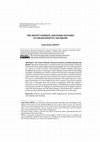
STUDIA UBB PHILOLOGIA, LXVII, 4, 2022
The Artist's Website. Discourse Features of Online Identity and Brand. 2 The present study aims t... more The Artist's Website. Discourse Features of Online Identity and Brand. 2 The present study aims to reveal those discourse particularities displayed by the artist's home page/website (used interchangeably for our current purposes 3) as a device to create an artist's online identity. Specific methods (and steps) throughout the process of creating an online identity overlap with the advertising strategies of branding. Our interest concerns the discourse strategies involved in the two activities in the context of online communication. The particularities of the artist's home page have been studied from a genre analysis perspective. The aim is to demonstrate that the genre features of the home page (as a cyber genre) determine or at least influence the site's content. The present research also aims to determine how the content is negotiated within the website's structure to serve the communicative goals of establishing an online identity and an artist's brand. The findings reveal several discourse strategies at play to reach the final purpose and that they belong to advertising and e-commerce, on the one hand, and the specialized field of the visual arts, on the other.
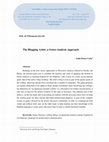
Journal of History Culture and Art Research, 2013
Building on the now classic approaches to Discourse Analysis offered by Swales and Bhatia, the pr... more Building on the now classic approaches to Discourse Analysis offered by Swales and Bhatia, the present paper tries to establish the benefits and value of applying the method of Genre Analysis to teaching English for Art Purposes, with a focus on a more recent Internet genre, that of the artist's blog (weblog). The artist's blog is seen as part of the greater genre of the weblog, which has already been classified into a number of subgenres. The paper proposes yet another dimension to be added to those already considered when classifying the weblogs: the dimension of "occupational-oriented content" as a descriptive for further classifications; it also tries to uncover the generic features of this type of discourse. The ultimate aim of this study is, on the one hand, that of providing art students with the necessary know-how of using the weblog genre for their current and future professional purposes, as part of the complex system of genres devised by the artistic discourse community in order to communicate both within and without itself, and, on the other hand, to help students use their knowledge of the English language to create such a discourse type in order to obtain maximum benefits.
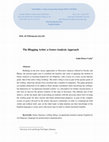
Journal of History Culture and Art Research, 2013
Building on the now classic approaches to Discourse Analysis offered by Swales and Bhatia, the pr... more Building on the now classic approaches to Discourse Analysis offered by Swales and Bhatia, the present paper tries to establish the benefits and value of applying the method of Genre Analysis to teaching English for Art Purposes, with a focus on a more recent Internet genre, that of the artist's blog (weblog). The artist's blog is seen as part of the greater genre of the weblog, which has already been classified into a number of subgenres. The paper proposes yet another dimension to be added to those already considered when classifying the weblogs: the dimension of "occupational-oriented content" as a descriptive for further classifications; it also tries to uncover the generic features of this type of discourse. The ultimate aim of this study is, on the one hand, that of providing art students with the necessary know-how of using the weblog genre for their current and future professional purposes, as part of the complex system of genres devised by the artistic discourse community in order to communicate both within and without itself, and, on the other hand, to help students use their knowledge of the English language to create such a discourse type in order to obtain maximum benefits.
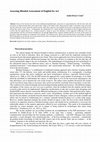
Noi tehnici si strategii în dinamica limbajelor de specialitate, 2018
Since art has become one facet of the multifaceted globalization, artists have to equip themselve... more Since art has become one facet of the multifaceted globalization, artists have to equip themselves with the best tools and
accessories to better promote their work and become visible to the whole world. Their presence online is obviously a first necessary
step they must take to stay within the general course, while their capacity to use English has become a prerequisite facilitator of any
actions they need to take to fit in. Consequently, the introduction of a virtual learning environment in the art higher education has
evolved into the natural thing to do. Current research is trying to assess the efficiency of this approach. Following a five-year
experimentation with the assessment of English for Art through applied Genre Analysis blended with the use of the on-line genres of
the artist’s blog and website, an evaluation of the method
is of common sense. Future steps and directions in developing an optimal
ESP methodology to fit both the current educational needs of the art students and the professional needs of the artists-to-be are to stem
from the findings of the present research.
TEHNICI ȘI STRATEGII DE SPECIALITATE ÎN DINAMICA LIMBAJELOR DE SPECIALITATE, 2017
Starting from the fundamental rights it fought for: Life, Liberty, and the pursuit of Happiness, ... more Starting from the fundamental rights it fought for: Life, Liberty, and the pursuit of Happiness, the American nation has built through history a whole system of inalienable values its citizens hold dear, which have shaped their way of life and their beliefs. Around these cornerstone values, they have built their religion, business, work and play, politics, and their culture and education, creating an American identity. Their art has also nourished on these values, in the meanwhile contributing to the completion of American cultural identity. Norman Rockwell is one of the best-loved such artists, his works speaking to his fellow Americans of the values they cherish and also reminding them what makes America great.
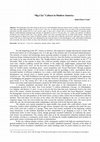
DINAMICA LIMBAJELOR DE SPECIALITATE TEHNICI ȘI STRATEGII INOVATOARE, 2016
The beginnings of the 20th century in the by now well-established American nation carried a numbe... more The beginnings of the 20th century in the by now well-established American nation carried a number of common features with what was happening in Europe, as well. It was a " new era " , in which the machine took over many of the previously human-performed activities, giving birth to a new society, eager to enjoy more comfort and an increasing number of consumer goods. Massive industrialization prompted large amounts of population to move to the big cities. As a result, new patterns of behavior developed, new cultural trends and a new, popular, culture were born coexisting with the so-called " high culture ". Modernism became apparent in almost every aspect of human existence, from daily life to literature and the arts. This paper tries to point out some of the ways in which big cities were influenced by the economic boom, by the technological, social, and political modernism and, conversely, the ways in which, in return, they influenced a number of American writers and artists at the turn of the century. Keywords: " the big city " , " a new era " , modernism, popular culture, " high culture " It is the beginning of the 20 th century in America. The impressive changes that had just started some 20-30 years before are in full progress now. It is the age of the machine and of accelerated industrialization. The miracles of science and technology attract growing numbers of people to the cities, in pursuit of their American dream, looking forward to the success they crave for. Once the frontier was declared closed, a new one seems to be open toward the skies. The Wright brothers have just flown their machine on the 17 th of December 1903, to the surprise of many who could not possibly imagine such endeavor and some twenty years later, Charles Lindberg crossed the Atlantic in his single-seat, single-engine, purpose-built Ryan monoplane, Spirit of St. Louis for the first time in human history. The Progressive Era politics began to show its fruitful results, smoothing down social inequalities and " Social Darwinism " through programs offering access of the masses to all levels of education and by providing a safer environment and an increased number of efficient workplaces. As a result, a solid middle class had a real chance to grow now. Immigration was slowed down to limited quotas for the different nationalities already extant on the American soil. The 1920 Prohibition Law had some unexpected repercussions consisting in the appearance of bootlegging and gangsters and growing criminality. However, this period is generally referred to as " the great boom " or as " the roaring 20's " due to the unprecedented flourishing of the American society as a whole (with some small reprieves/hiatuses caused by the WWI and the short recession after that). A ceaseless population movement from the rural parts to the industrialized cities lead to an unimaginable growth of the latter: New York reached 7.5 million inhabitants, Chicago, 3.4, Philadelphia, Los Angeles, and Detroit 1.5 each. It was in fact for the first time that more Americans lived in the cities than in the country. Another movement, from South to North, the so-called " the Great Migration " , changed the demographic structure of the northern industrialized cities, since the majority of the people heading there were blacks, the sons and grandsons of the freed slaves, trying to make a better life for themselves and their families. They had taken over the jobs of the whites who had been fighting in the war. A newer type of migration began, from the overcrowded big cities toward the suburban residential areas. The newly paved roads, the cars, the elevated trains made commuting to and from work in the big town quite easy. The suburbs were mainly populated by upper-middle class people who could afford a house with electricity, modern indoor plumbing and sewage system, equipped with every appliance that made life easy, with a back yard and a carport or a garage. These areas were mainly residential at the beginning, without many businesses; so the residents depended on their automobiles to go shopping or even to work. The architectural styles of these houses varied, though generally remained traditional; in California the ranch-style houses was predominant. The country clubs came to be the representative suburban landmark during the twenties, serving as a community social center, by offering the wealthy neighborhood such facilities as sports (golf, tennis, swimming) and all kinds of entertainment. In the city, ordinary people, workers, clerks, immigrants resided in the high-rise apartment-houses, a general tendency in all crowded urban areas. The so-called " dumbbell tenements " (because of the shape of the floorplan which resembled a dumbbell) were rather buildings made for profit without too much worry 1 Dr. A.E. Crețiu is an Assoc. Prof. with The Dept. Of Theoretical Disciplines of the University of Art and Design in Cluj-Napoca

Compositional canons tend to place the most important thing/character in the focal point and, pro... more Compositional canons tend to place the most important thing/character in the focal point and, probably, the center of a painting would be such a position. A basic device the discourse about art deals with is the formal analysis, viewed both as a genre with its own purposes and structure, and as a discoursal strategy serving to achieving other genre's goals. The text intended for analysis in what follows is in fact a fragment of a larger article in an art magazine, by Andrée Hayum, entitled The Courtly Art of Dosso Dossi 1. The fragment itself does not have a title of its own, but if it had one, that would probably be Dosso Dossi's " Jupiter, Mercury, and Virtue ". The importance the author of the article places on this specific fragment can easily be inferred from the fact that it is placed at the end of the whole, it is rather lengthy as compared to the previous parts, it is graphically separated from the rest by a space and the initial letter is graphically marked (in bold). After going through it all, we realize that it can be considered a text in its own right, a text belonging to the genre of formal analysis, as may come out from the demonstration below. A basic device the discourse about art deals with is the formal analysis, viewed both as a genre with its own purposes and structure, and as a discoursal strategy serving to achieving other genre's goals. The formal analysis is one type of critical essay; from this point of view, we may consider it a sub-genre; but if we consider the basic requests a genre proper must meet 2 , then we can easily notice that the formal analysis has its own purposes, its own standard move-pattern, its own discoursal strategies. Its name is obviously derived from the verb " to analyse " = to take a whole apart in order to discover how the pieces work together to create it. It is exactly what a formal analysis is supposed to do: to deconstruct an artwork into its formal elements in order to see how these formal elements work together to contribute to the general impression the whole makes on the viewer (here including its meaning). Under formal elements art literature usually lists such things as: subject-matter (that which can easily be discerned when looking at an artwork: e.g.: a spot in nature, characters, just lines; the title of the artwork can also be considered as belonging to the subjecy-matter), specific formal elements (e.g. lines, shapes, colour, volume, space—perspective either atmospheric/aerial or linear/geometric, light, time, texture, etc), priciples of design (e.g. balance, focal point, dominance, rhythm, scale, proportion, unity, variety). Formal analysis presupposes the skillful description of the most important elements appearing in the work, but it cannot be reduced only to it (a mistake art students seem to make). Formal analysis is a step forward towards discerning what meanings lie beneath the beautiful surface created by the masterly handling of such elements subordinated to the artist's vision of the world. Formal analysis is both form and meaning.
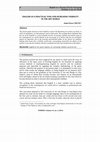
The present paper focuses on how English is used in the Romanian art context, by whom, in what ci... more The present paper focuses on how English is used in the Romanian art context, by whom, in what circumstances, to what purposes, and to what avail. The working thesis maintains that the use of Art English is a most valuable tool for increasing visibility and market value in the contemporary art world. Results so far encourage us to believe that the use of English played an important role in the growing international public of our former art students, helping them boost their visibility worldwide , encouraging meanwhile the efforts of the teacher to provide the students with this wonderful tool they may benefit from in the future. The present research has been triggered by my desire to check upon the score of efficiency of the many years of teaching English for Art Purposes by applying various methods of teaching/learning English for specific and for academic purposes and especially by applying the complex methodology of the genre analysis. Therefore the purpose of the present paper is to distinguish in what ways and to what results the language abilities of using English for art purposes have been put to work by the graduates of the University of Art and Design in Cluj-Napoca, some of whom have recently become very famous on an international level and highly valued on the art market (making it possible for the Cluj School to become known) in order to increase their international visibility. The working thesis maintains that English is a most valuable tool to achieve recognition in the contemporary art world and to contribute to professional and financial success in it. The curriculum adopted by The University of Art and Design in Cluj-Napoca has allotted two years for the study of a foreign language; there is one teaching hour in the first year (a seminar class per week) and two hours in the second year (one course and one seminar class). After a first year of study, when the stress is placed
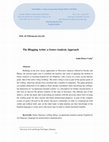
Building on the now classic approaches to Discourse Analysis offered by Swales and Bhatia, the pr... more Building on the now classic approaches to Discourse Analysis offered by Swales and Bhatia, the present paper tries to establish the benefits and value of applying the method of Genre Analysis to teaching English for Art Purposes, with a focus on a more recent Internet genre, that of the artist's blog (weblog). The artist's blog is seen as part of the greater genre of the weblog, which has already been classified into a number of subgenres. The paper proposes yet another dimension to be added to those already considered when classifying the weblogs: the dimension of " occupational-oriented content " as a descriptive for further classifications; it also tries to uncover the generic features of this type of discourse. The ultimate aim of this study is, on the one hand, that of providing art students with the necessary know-how of using the weblog genre for their current and future professional purposes, as part of the complex system of genres devised by the artistic discourse community in order to communicate both within and without itself, and, on the other hand, to help students use their knowledge of the English language to create such a discourse type in order to obtain maximum benefits.
Art is (or should be) interpreted according to a number of principles, more or less clearly state... more Art is (or should be) interpreted according to a number of principles, more or less clearly stated throughout the existence of what is generally called art criticism. The language (discourse) used to do that presents some particularities which may be inscribed within what a scholar named "a hermeneutic circle."
Constructions of Identity III, Proceedings of the International Conference 23-25 April 2004, 2006
Probably the most important genre mediated by language through which artists communicate with the... more Probably the most important genre mediated by language through which artists communicate with their public, the artist's statement rounds up the image and the meaning of the work in the viewer's mind by offering a glimpse into its creator's universe.
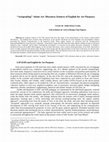
Diversitate Culturală și Limbaje de Specialitate, 2013
One frequent interest of the ESP research has been the study of the particularities of the variou... more One frequent interest of the ESP research has been the study of the particularities of the various content-related discourse(s). The findings have revealed some preferences of the specific discourses for some linguistic and non-linguistic features governing the efficient communication in the respective fields. These regular features are consistent with the communicative purposesestablished by every discourse community. In the field of visual arts there have been many debates whether the type of discourse named by some "Artspeak" and by others "International Art English" is a necessity for the artistic discourse community, or whether it should by all means be avoided. Both linguists, on the one hand, and artists, critics, curators (field specialists), on the other, advocated in favour of either approach.The present study attempts at discovering what the typical features of this kind of discourse are and how they are perceived by both the specialized audience and the general public. These peculiarities do not refer only to the specific lexis, but also to the syntax,the semantics, and the rhetoric of paragraphs and even whole texts.
Books by Anda-Elena Crețiu
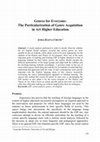
Limbaje specializate. Perspective si linii de convergenta, 2019
A needs analysis performed in order to decide what the syllabus for Art English should comprise r... more A needs analysis performed in order to decide what the syllabus for Art English should comprise revealed that certain genres are more suitable for the art students, while others seem to be more appropriate for the students of the History and Theory of Art program. Since one of the most important goals of teaching and learning ESP in higher education is that of preparing students for their future careers, the teacher should consider the different particularities of the target groups and adapt both the syllabus and the teaching-learning methods accordingly. A previous study on the use of some online genres (artist blog and website) by art students revealed that they understand and appreciate both the value of such contemporary tools and the important role the English language plays in this context, meanwhile welcoming the newer methodological approach of blended learning. The success this method has scored for about 10 years now is encouraging the ESP teacher to also adopt it for the newer program of The History and Theory of Art, with a focus on certain specific genres (art news, art review), while also efficiently making use of those employed by their art colleagues. Experience has proven that the teaching of foreign languages in the context of higher education necessarily presupposes an inspired approach to the motivations and purposes for which these languages are used by the students as future professionals in their specific fields of activity. This aspect brings into discussions the specificity of the language being taught/studied; therefore, the natural approach should be the ESP one. Any conscious attempt to devise an efficient curriculum for the teaching of a certain specific language starts with a realistic needs analysis, followed by the decision to adopt one or more linguistic and pedagogical approaches. There is no general ESP, but situation-specific ESP, since the social context 1 Associate Professor, University of Art and Design.
Conference Presentations by Anda-Elena Crețiu
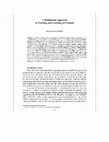
Limbajele specializate în era digitală: Abordări metodologice și practice, Roxana‐Maria Nistor & Camelia Teglaș (editori), Presa Universitară Clujeană, 2022
The last two years have prompted educators worldwide to adopt novel strategies to reach their aca... more The last two years have prompted educators worldwide to adopt novel strategies to reach their academic goals. Given the distance imposed by the pandemic, they had to recourse to CMC (computer-mediated communication) and use Internet tools as efficiently as possible. One of the most powerful tools the Internet offers is (almost) unlimited access to information and resources of all types. A wide variety of images, spoken and written texts, and new(er) and old(er) genres adapted to cyberspace have proved an invaluable help for ESP teachers. These multimodal instruments have been massively adopted in teaching and learning English for Art Purposes at different competence levels for teaching activities as well as for assessing students' work. For the first-year students of UAD Cluj, the multimodal texts were mainly aimed at developing their reading and listening (about art) abilities. The second-year students also used them to speak and write about art within the frame of Applied Genre Analysis. The present paper wishes to share some of these experiences over the last two years while also weighing the results of this enterprise. Possible developments of the multimodal approach are discussed for setting new goals and sketching new directions and methods for the post-pandemic years since it has become evident that the recent experiences need to be further improved to bear new fruition.
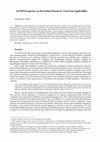
LIMBAJELE SPECIALIZATE ÎN CONTEXTUL NOILOR MEDII DE ÎNVĂȚARE: Provocări și oportunități. Presa Universitara Clujeana, 2020
The present study focuses on some particularities of the discourse of fashion as to its microstru... more The present study focuses on some particularities of the discourse of fashion as to its microstructure level, especially. The research of a corpus of 32 different texts included in ten specialized fashion magazines published this year is meant to reveal certain peculiarities of the discourse used by this community. The interest lies in the level of the specific lexis mainly and the way it determines some morpho-syntax, semantics, and rhetorical features, with an attempt to distinguish possible established discourse structures. Another point of interest is that of establishing certain similarities and differences between this kind of discourse and that of art, in general, to facilitate a better understanding of the communicative needs of the respective students. A final comparison of the cumulative findings to 20 texts written by the 2020 graduates of Fashion Design (designer concept statements) is meant to inspire a more effective approach to the teaching of specialized English to this group of students, in view of their future professional communicative purposes. Premises Over the last decades, the dynamics of specialized language(s) and the corresponding studies have met with amazing growth, worldwide. With English as a lingua franca, several fields have already established themselves as classical, such as Business English (which has diversified into subfields such as English for Business Communication, English for Academic and Occupational Business Purposes, English for Management, Economics, Marketing, etc.), English for Tourism, Medical English, English for Engineers, Legal English, English for Science and Technology, etc. Such a large sub-disciplinary variation has raised many challenges for those teaching the respective branch-related languages, as to the designing, implementing, and teaching the courses. Involved in an extensive three-year study of possible variations across what is usually referred to as Business English, based on the textual and communicative problems both students and teachers experienced, Bhatia mentions that "the textual and academic performance perspectives clearly showed that although there were some common features that formed an academic core in the business discourse, there were nonetheless distinctive generic characteristics, which were reflective of the requirements of the different sub-disciplines in BBA programs". Therefore, he continues, The research findings clearly supported the view that EBP [English for Business Purposes] needs to develop a discourse-and-genre-based cross-disciplinary approach, taking into account the dynamic aspects of disciplinary tensions, to create appropriate conditions for meeting the inter-disciplinary discourse-based demands placed on new students in the academy and to meet the business community needs for multidisciplinary communicative expertise. (Bhatia, 2012, p. 13) There is also the problem of establishing the right relation between teaching the specific language in class and the real-life experience of using the language in the respective professional field. If the core coordinates of the larger field of ESP have not changed drastically since 1997, when Dudley-Evans described it in terms of absolute 2 and variable characteristics 3 (p. 6, and 1998, p. 4-5), and the role of the ESP practitioner schematically remained quite the same as described by the same author, that of a teacher, collaborator, course designer and materials provider, researcher and evaluator, what keeps evolving and continually changing is the reality or, the context of the field the specific language is used for or, into. As a consequence, it is only natural that the ESP practitioner (teacher) needs to keep in permanent touch with the respective reality, research it, adapt to it, try to find the best and the most effective ways in which to implement the findings to the final 1 Associate Professor, University of Art and Design in Cluj-Napoca 2 1. ESP is defined to meet specific needs of the learners: 2. ESP makes use of underlying methodology and activities of the discipline it serves; 3. ESP is centered on the language appropriate to these activities in terms of grammar, lexis, register, study skills, discourse and genre. 3 1. ESP may be related to or designed for specific disciplines; 2. ESP may use, in specific teaching situations, a different methodology from that of General English; 3. ESP is likely to be designed for adult learners, either at a tertiary level institution or in a professional work situation. It could, however, be for learners at secondary school level 4. ESP is generally designed for intermediate or advanced students. 5. Most ESP courses assume some basic knowledge of the language systems






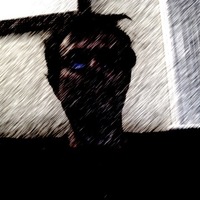


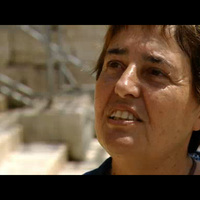
Uploads
Papers by Anda-Elena Crețiu
accessories to better promote their work and become visible to the whole world. Their presence online is obviously a first necessary
step they must take to stay within the general course, while their capacity to use English has become a prerequisite facilitator of any
actions they need to take to fit in. Consequently, the introduction of a virtual learning environment in the art higher education has
evolved into the natural thing to do. Current research is trying to assess the efficiency of this approach. Following a five-year
experimentation with the assessment of English for Art through applied Genre Analysis blended with the use of the on-line genres of
the artist’s blog and website, an evaluation of the method
is of common sense. Future steps and directions in developing an optimal
ESP methodology to fit both the current educational needs of the art students and the professional needs of the artists-to-be are to stem
from the findings of the present research.
Books by Anda-Elena Crețiu
Conference Presentations by Anda-Elena Crețiu
accessories to better promote their work and become visible to the whole world. Their presence online is obviously a first necessary
step they must take to stay within the general course, while their capacity to use English has become a prerequisite facilitator of any
actions they need to take to fit in. Consequently, the introduction of a virtual learning environment in the art higher education has
evolved into the natural thing to do. Current research is trying to assess the efficiency of this approach. Following a five-year
experimentation with the assessment of English for Art through applied Genre Analysis blended with the use of the on-line genres of
the artist’s blog and website, an evaluation of the method
is of common sense. Future steps and directions in developing an optimal
ESP methodology to fit both the current educational needs of the art students and the professional needs of the artists-to-be are to stem
from the findings of the present research.